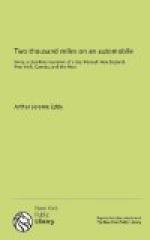So far as finding and keeping the road is concerned,—and it is a matter of great concern in this vast country, where roads, cross-roads, forks, and all sorts of snares and delusions abound without sign-boards to point the way,—the following directions may be given once for all:
If the proposed route is covered by any automobile hand-book or any automobile publication, get it, carry it with you and be guided by it; all advice of ancient inhabitants to the contrary notwithstanding.
If there is no publication covering the route, take pains to get from local automobile sources information about the several possible routes to the principal towns which you wish to make.
If you can get no information at all from automobile sources, you can make use—with great caution—of bicycle road maps, of the maps rather than the redlined routes.
About the safest course is to spread out the map and run a straight line between the principal points on the proposed route, note the larger villages, towns, and cities near the line so drawn, make a list of them in the order they come from the starting-point, and simply inquire at each of these points for the best road to the next.
If the list includes places of fair size,—say, from one to ten or twenty thousand inhabitants, it is reasonably certain that the roads connecting such places will be about as good as there are in the vicinity; now and then a better road may be missed, but, in the long run, that does not matter much, and the advantage of keeping quite close to the straight line tells in the way of mileage.
It is usually worse than useless to inquire in any place about the roads beyond a radius of fifteen or twenty miles; plenty of answers to all questions will be forthcoming, but they simply mislead. In these days of railroads, farmers no longer make long overland drives.
It is much easier to get information in small villages than in cities. In a city about all one can learn is how to get out by the shortest cut. Once out, the first farmer will give information about the roads beyond.
In wet weather the last question will be, “Is the road clayey or bottomless anywhere?” In dry weather, “Is there any deep, soft sand, and are there any sand hills?”
The judgment of a man who is looking at the machine while he is giving information is biased by the impressions as to what the machine can do; make allowances for this and get, if possible, an accurate description of the condition of any road which is pronounced impassable, for you alone know what the machine can do, and many a road others think you cannot cover is made with ease.
To the farmer the automobile is a traction engine, and he advises the route accordingly; he will even speculate whether a given bridge will support the extraordinary load.
Once we were directed to go miles out of our way over a series of hills to avoid a stretch of road freshly covered with broken stone, because our solicitous friends were sure the stones would cut the rubber tires.




